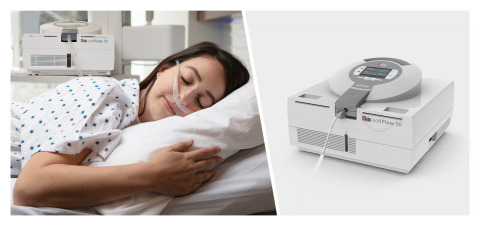Masimo Announces U.S. Release of softFlow® High-Flow Nasal Cannula Therapy
Masimo (NASDAQ: MASI) has launched softFlow®, a new pulmonary care therapy providing high-flow warmed and humidified gases for spontaneously breathing patients. The device, approved for use in hospitals and home settings, helps manage respiratory conditions, particularly in COVID-19 patients. softFlow operates without external air supply and features a dedicated flow path for safety. Supported by clinical data, it has shown improved patient outcomes, with capabilities to enhance comfort and facilitate communication. The technology is already being used globally since its first introduction in 2016.
- Launch of softFlow®, enhancing respiratory support capabilities for COVID-19 patients.
- FDA clearance for use in hospitals and long-term care, expanding market reach.
- Clinical studies indicate improved patient outcomes compared to conventional therapies.
- None.
Insights
Analyzing...
Masimo (NASDAQ: MASI) today announced the U.S. introduction of softFlow®, innovative pulmonary care therapy which provides nasal high-flow warmed and humidified respiratory gases to spontaneously breathing patients. The technology, available on the softFlow 50, offers adult patients high-flow respiratory support through a soft nasal cannula by generating a consistent high flow of warm, humidified air or air/oxygen mixture.

Masimo softFlow® (Photo: Business Wire)
As the COVID-19 pandemic continues, increasing the number of patients suffering from respiratory conditions and requiring respiratory support, softFlow offers clinicians across the continuum of care an important tool to help in the treatment of spontaneously breathing patients. Capable of operating without an external compressed air supply, softFlow is designed for maximum versatility, with utility in settings throughout the hospital, long term-care facilities, and use at home. To reduce the risk of cross-contamination, softFlow uses a single-patient-use flow path from the internal mixing chamber to the patient and a bacterial/viral filter designed to filter contaminants from the air delivered to the patient.
The U.S. National Institutes of Health (NIH) and World Health Organization (WHO) have both suggested that the use of High-Flow Nasal Cannula (HFNC) therapy, like softFlow, is a viable option for providing respiratory support for select COVID-19 patients for whom conventional oxygen therapy may be insufficient.1 softFlow can provide patients suffering from COVID-19 or other respiratory conditions with higher flow rates of oxygen than conventional oxygen therapies. As a therapy, NIH concluded, “HFNC is preferred over Noninvasive Positive Pressure Ventilation (NIPPV) in patients with acute hypoxemic respiratory failure based on data from an unblinded clinical trial in patients without COVID-19 who had acute hypoxemic respiratory failure.”2 The referenced study found a higher number of ventilator-free days (24 days) with HFNC than with conventional oxygen therapy (22 days) or NIPPV (19 days) (p=0.02). The researchers also found a lower 90-day mortality rate compared to conventional oxygen therapy or NIPPV.3
With softFlow, the airflow is consistently delivered through the nose, allowing patients to continue to eat, drink, and speak, which is difficult with mask-based forms of respiratory support. In addition, the softFlow 50 system provides warm, humidified gas into the patient’s nose, to enhance comfort and aid in mucous clearance.4,5 With its ability to precisely deliver high respiratory gas flow rates well above those required for typical respiratory demand, clinicians can also take advantage of the high-flow rate to help limit the entrainment of room air (which can reduce the quantity of delivered inhaled oxygen).
The innovative integrated airflow generator of the softFlow technology and water reservoir attachment allow for continued HFNC treatment of recovering COVID-19 patients in the home and other care settings, without the need for a separate source for high-flow air like other devices. The device’s simple, intuitive interface allows patients or their caregivers (who can lock settings) to easily customize the flow rate and humidification level.
First available in 2016, softFlow is now in use in numerous countries in Africa, Asia, and Europe.
Beijing Aerospace Changfeng Co., LTD, of China, noted, “We are very satisfied with the therapy successes we achieve with this device. We would like to emphasize the stable flow during inhalation and exhalation, which is generated by the powerful motor, which doesn’t need an external air source, as well as the resulting CO2 washing out. This fact opens up possibilities for [use as] a therapy for hypercapnic patients. Another very positive aspect of the device is the way it prevents condensation in the applicator by warming the entire tube system up to the nasal cannula. … All in all we are very satisfied with the handling of the device and the medical results.”
Miguel Marina Barrio, Product Manager, Intensive Care Division, Hospital Hispania, Spain, added, “We already ordered 50 devices and we are very satisfied with the way softFlow performed. … In our opinion, the following points are very good: menu structure, product features, design, usability, manuals, delivery times. … The product quality, customer service, and type of packaging are particularly excellent.”
Dr. Dalal Al Matrouk, Head of Anesthesia and ICU at Farwaniya Hospital, Ministry of Health, Kuwait, said, “We have deployed 10 units of Masimo softFlow to help our clinicians manage patients with COVID-19-induced respiratory problems. We realize that high-flow nasal therapy could potentially help avoid invasive mechanical ventilation and its associated risks of ventilator-induced lung injury and hospital-acquired pneumonia.”
Joe Kiani, Founder and CEO of Masimo, said, “We believe softFlow provides clinicians with an important tool to help address the growing number of people with compromised respiratory function, whether in high-acuity or low-acuity settings, including at home. We’re happy to now be able to offer this technology in the United States.”
@Masimo | #Masimo
The softFlow 50 is FDA cleared for use in hospital and long-term care facilities. Home use is being made available in the US under the FDA Enforcement Policy for Ventilators and Accessories and Other Respiratory Devices During the COVID-19 Public Health Emergency.
About Masimo
Masimo (NASDAQ: MASI) is a global medical technology company that develops and produces a wide array of industry-leading monitoring technologies, including innovative measurements, sensors, patient monitors, and automation and connectivity solutions. Our mission is to improve patient outcomes and reduce the cost of care. Masimo SET® Measure-through Motion and Low Perfusion™ pulse oximetry, introduced in 1995, has been shown in over 100 independent and objective studies to outperform other pulse oximetry technologies.6 Masimo SET® has also been shown to help clinicians reduce severe retinopathy of prematurity in neonates,7 improve CCHD screening in newborns,8 and, when used for continuous monitoring with Masimo Patient SafetyNet™ in post-surgical wards, reduce rapid response team activations, ICU transfers, and costs.9-12 Masimo SET® is estimated to be used on more than 200 million patients in leading hospitals and other healthcare settings around the world,13 and is the primary pulse oximetry at 9 of the top 10 hospitals according to the 2020-21 U.S. News and World Report Best Hospitals Honor Roll.14 Masimo continues to refine SET® and in 2018, announced that SpO2 accuracy on RD SET® sensors during conditions of motion has been significantly improved, providing clinicians with even greater confidence that the SpO2 values they rely on accurately reflect a patient’s physiological status. In 2005, Masimo introduced rainbow® Pulse CO-Oximetry technology, allowing noninvasive and continuous monitoring of blood constituents that previously could only be measured invasively, including total hemoglobin (SpHb®), oxygen content (SpOC™), carboxyhemoglobin (SpCO®), methemoglobin (SpMet®), Pleth Variability Index (PVi®), RPVi™ (rainbow® PVi), and Oxygen Reserve Index (ORi™). In 2013, Masimo introduced the Root® Patient Monitoring and Connectivity Platform, built from the ground up to be as flexible and expandable as possible to facilitate the addition of other Masimo and third-party monitoring technologies; key Masimo additions include Next Generation SedLine® Brain Function Monitoring, O3® Regional Oximetry, and ISA™ Capnography with NomoLine® sampling lines. Masimo’s family of continuous and spot-check monitoring Pulse CO-Oximeters® includes devices designed for use in a variety of clinical and non-clinical scenarios, including tetherless, wearable technology, such as Radius-7® and Radius PPG™, portable devices like Rad-67™, fingertip pulse oximeters like MightySat® Rx, and devices available for use both in the hospital and at home, such as Rad-97®. Masimo hospital automation and connectivity solutions are centered around the Masimo Hospital Automation™ platform, and include Iris® Gateway, Patient SafetyNet, Replica™, Halo ION™, UniView™, UniView 60™, and Masimo SafetyNet™. Additional information about Masimo and its products may be found at www.masimo.com. Published clinical studies on Masimo products can be found at www.masimo.com/evidence/featured-studies/feature/.
ORi and RPVi have not received FDA 510(k) clearance and are not available for sale in the United States. The use of the trademark Patient SafetyNet is under license from University HealthSystem Consortium.
References
- https://www.who.int/docs/default-source/coronaviruse/clinical-management-of-novel-cov.pdf
- https://www.covid19treatmentguidelines.nih.gov/critical-care/oxygenation-and-ventilation/
- Frat JP, Thille AW, Mercat A, et al. High-flow oxygen through nasal cannula in acute hypoxemic respiratory failure. N Engl J Med. 2015;372(23):2185-2196. Available at: https://www.ncbi.nlm.nih.gov/pubmed/25981908.
- Hasani A et al. Chron Respir Dis 5, no. 2 (2008): 81-86.
- Roca O et al. Respir Care 55, no. 4 (2010): 408-413.
- Published clinical studies on pulse oximetry and the benefits of Masimo SET® can be found on our website at http://www.masimo.com. Comparative studies include independent and objective studies which are comprised of abstracts presented at scientific meetings and peer-reviewed journal articles.
- Castillo A et al. Prevention of Retinopathy of Prematurity in Preterm Infants through Changes in Clinical Practice and SpO2 Technology. Acta Paediatr. 2011 Feb;100(2):188-92.
- de-Wahl Granelli A et al. Impact of pulse oximetry screening on the detection of duct dependent congenital heart disease: a Swedish prospective screening study in 39,821 newborns. BMJ. 2009;Jan 8;338.
- Taenzer A et al. Impact of pulse oximetry surveillance on rescue events and intensive care unit transfers: a before-and-after concurrence study. Anesthesiology. 2010:112(2):282-287.
- Taenzer A et al. Postoperative Monitoring – The Dartmouth Experience. Anesthesia Patient Safety Foundation Newsletter. Spring-Summer 2012.
- McGrath S et al. Surveillance Monitoring Management for General Care Units: Strategy, Design, and Implementation. The Joint Commission Journal on Quality and Patient Safety. 2016 Jul;42(7):293-302.
- McGrath S et al. Inpatient Respiratory Arrest Associated With Sedative and Analgesic Medications: Impact of Continuous Monitoring on Patient Mortality and Severe Morbidity. J Patient Saf. 2020 14 Mar. DOI: 10.1097/PTS.0000000000000696.
- Estimate: Masimo data on file.
- http://health.usnews.com/health-care/best-hospitals/articles/best-hospitals-honor-roll-and-overview.
Forward-Looking Statements
This press release includes forward-looking statements as defined in Section 27A of the Securities Act of 1933 and Section 21E of the Securities Exchange Act of 1934, in connection with the Private Securities Litigation Reform Act of 1995. These forward-looking statements include, among others, statements regarding the potential effectiveness of softFlow®. These forward-looking statements are based on current expectations about future events affecting us and are subject to risks and uncertainties, all of which are difficult to predict and many of which are beyond our control and could cause our actual results to differ materially and adversely from those expressed in our forward-looking statements as a result of various risk factors, including, but not limited to: risks related to our assumptions regarding the repeatability of clinical results; risks related to our belief that Masimo's unique noninvasive measurement technologies, including TNI softFlow, contribute to positive clinical outcomes and patient safety; risks related to our belief that Masimo noninvasive medical breakthroughs provide cost-effective solutions and unique advantages; risks related to COVID-19; as well as other factors discussed in the "Risk Factors" section of our most recent reports filed with the Securities and Exchange Commission ("SEC"), which may be obtained for free at the SEC's website at www.sec.gov. Although we believe that the expectations reflected in our forward-looking statements are reasonable, we do not know whether our expectations will prove correct. All forward-looking statements included in this press release are expressly qualified in their entirety by the foregoing cautionary statements. You are cautioned not to place undue reliance on these forward-looking statements, which speak only as of today's date. We do not undertake any obligation to update, amend or clarify these statements or the "Risk Factors" contained in our most recent reports filed with the SEC, whether as a result of new information, future events or otherwise, except as may be required under the applicable securities laws.
View source version on businesswire.com: https://www.businesswire.com/news/home/20210223005332/en/







